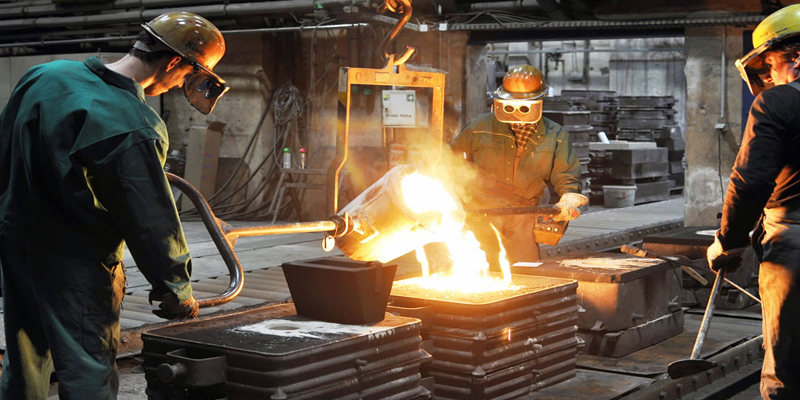
A foundry may operate more effectively and safely, improving quality and minimizing waste, with the aid of a correctly installed thermal analysis system. These systems enable the recording and analysis of a continuous temperature profile by combining a sample cup, a temperature probe, and specialized devices to read the sensors. For molten pouring systems, they can also check temperatures to guarantee high-quality and reliable output.
This kind of technology has long been used in the metal foundry sector and is an essential component of well-maintained manufacturing facilities. Compared to optical temperature measurements, which can only approximate surface temperatures and are frequently affected by outside influences like fumes, it yields data that are significantly more accurate. To meet your needs, however, the components of these thermal analysis systems, such as thermocouples, portable pyrometers, and samplers, must be properly chosen. When used properly, a thermal analysis system can provide the following advantages:
Improve Quality
Temperatures during metal casting must stay within the permitted range chosen by the metallurgical and quality department. Lower temperatures may result in casting issues, while higher temperatures use more energy, are harsher on refractories, result in fewer eutectic cells in iron, necessitate cool-down periods, and may result in casting issues such surface flaws. Cast items will continuously be of higher quality and have fewer flaws if the acceptable range is maintained.
Increase Production Efficiency
Inefficient temperature control is linked to a lot of downtime. As was already said, cooling and heating require time, and uneven temperatures might result in flaws in the finished product. Either these flaws need to be fixed, or the product needs to be destroyed and made from scratch. For daily operations to run smoothly, foundry production must be consistent. A robust thermal analysis system enables manufacturers to correct any temperature discrepancies before they pose issues further along the production process.
Reduce Material Waste
To reduce potential land pollution from chemicals like zinc, material waste from the casting process must be disposed of carefully and effectively. Production waste may be disposed of in landfills or may need additional disposal procedures, such as incineration, to ensure compliance and safety.
Some waste from the casting process is unavoidable, including as packaging elements, trash from ancillary processes, and slag. Temperature variations, on the other hand, can significantly increase the volume of trash that must be processed and disposed of. This results in higher administrative and personnel expenditures, as well as raw material disposal costs. Furthermore, as the requirement for disposal grows, so does the likelihood of errors in the process. Investing in a precise and dependable thermal control system results in fewer defective goods, less waste, and less risk.
Keep Foundry Workers Safe
Foundries are required to maintain safe working conditions at all times. Foundries must take extra precautions to avoid exposing workers to harmful molten metal temperatures and to keep the temperature exposure within safe limits due to the higher risk of working with the volatile chemicals involved. Employees are at danger because too much temperature variation makes it difficult to establish these exposure limits. Employees in foundries are at risk from both internal and exterior heat, including
- Heat rash
- Fainting
- Heatstroke
- Burns
The risk of unexpected, external exposure to excessive heat while working with molten pouring systems is reduced by consistent temperatures, which allow workers to finish shifts without worrying about exposure restrictions and any unsafe temperatures will be identified sooner.
Protect Equipment
Inappropriate temperatures can cause damage to production equipment, either immediately or over time due to wear. The equipment will survive longer and generate superior materials if it is only exposed to constant temperatures. This improves overall efficiency, lowers costs associated with repair and replacement, and further decreases waste. Keep in mind that defective equipment can affect the health and safety of the personnel who use and maintain it in addition to costing money.
Can low-quality foundries benefit from thermal analysis systems?
Increased temperature control can have a significant positive impact on foundries, perhaps even more so than foundries that use scrap metals and operate without a spectrometer lab. Because these foundries frequently rely on visual inspection of slag to gauge temperature and rarely check for silicone, copper, or other metals, they require sophisticated temperature monitoring systems. This increases the possibility of unstable metallurgical characteristics for the foundry. For these low-quality foundries, accurate temperature measurement and management with a thermal analysis system stabilizes production while simultaneously providing the above-mentioned advantages.
How do I select the right temperature equipment?
The quality of your thermal analysis system depends on each of its parts. The setup of your factory and your production requirements will determine which solutions are optimal. Considerable factors include
- Desired temperature range
- Size of the area to be measured
- Environmental conditions
- The materials you work with
To make sure your plant is set up for long-term success, carefully weigh your options while taking into account all aspects of your molten metal application demands. This will ensure that your system lasts a long time and leverage the advantages of stable temperature measurements.
AAVAD provides a wide range of thermocouples, including types S, K, B, and R, analysis systems, wall-mounted pyrometers, handheld pyrometers, calibration checkers, and different solutions for controlling foundry temperature. To help you choose the system that best suits your needs, our experts are prepared and eager to help.











